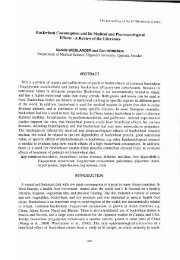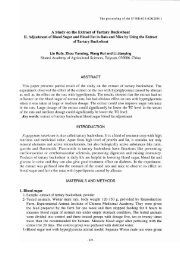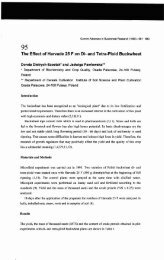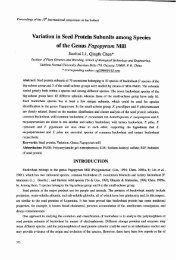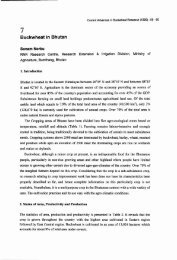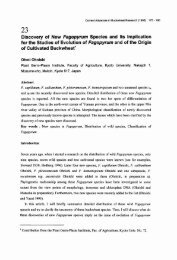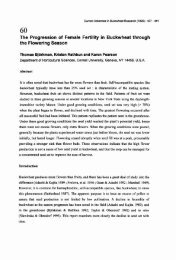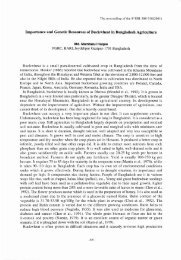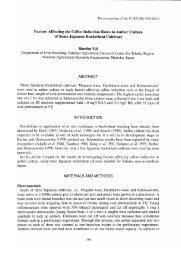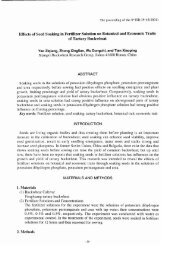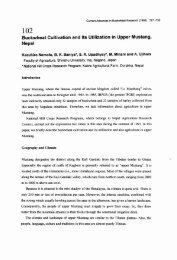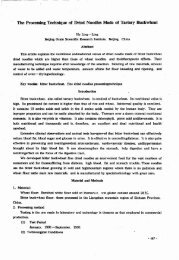40. Studies on Chromosomes Doubling of Tartary Buckwheat
40. Studies on Chromosomes Doubling of Tartary Buckwheat
40. Studies on Chromosomes Doubling of Tartary Buckwheat
You also want an ePaper? Increase the reach of your titles
YUMPU automatically turns print PDFs into web optimized ePapers that Google loves.
314<br />
Materials and Methods<br />
In the spring <strong>of</strong> 1989, the three varieties <strong>of</strong>tartary buckwheat, namely, Eluowuqie, Shichee and<br />
Kuciqiao were cultivated in pots at the Agricultural Test Stati<strong>on</strong> <strong>of</strong> Xichang Agricultural<br />
College. Forty pots were planted for each variety. After the seeds sprouted, four plants were<br />
kept in each pot. The following method <strong>of</strong> treatment for the doubling <strong>of</strong> the chromosomes <strong>of</strong><br />
Jiujiang tartary buckwheat was used [9, 10]. After 2-3 leaves appeared, absorbent cott<strong>on</strong> balls<br />
were placed <strong>on</strong> the growing point <strong>of</strong> the leafstalk. A soluti<strong>on</strong> mixture <strong>of</strong> colchicine (0.2%) and<br />
dimethyl sulfoxide (1.5%) was dropped <strong>on</strong> the growing point. This was d<strong>on</strong>e twice a day (<strong>on</strong>e<br />
in the morning and the other in the evening) for six days.<br />
The following tasks were completed : the botanical characteristics were identified and the<br />
number <strong>of</strong>chromosomes <strong>of</strong>the root tip cells were examined and counted. After the seeds <strong>of</strong> the<br />
above menti<strong>on</strong>ed plants were obtained and treated, they were sowed in the Autumn <strong>of</strong>the same<br />
year. Good plants were selected when ripe. Each variety <strong>of</strong>seed was sowed and harvested at the<br />
same times.<br />
In 1990, the seeds <strong>of</strong> the three varieties <strong>of</strong> autotetraploid tartary buckwheat and its diploid<br />
parent stock were respectively sowed in large fields in holes 35 cm apart. After sprouting, four<br />
plants were retained in each hole. During the seedling stage the peroxidase isozymes <strong>of</strong> their<br />
leaves were electrophoreticly analyzed and stained with benzidine diaminodiphenyl.<br />
Photographs were taken immediately [11]. The following tasks were completed: the botanical<br />
characteristics were identified and recorded ; leaf guard cells, pollen grains and the sizes <strong>of</strong><br />
their root tip mitotic cells were examined, and measured during flowering period. The seeds<br />
were dried when they were ripe and the amounts <strong>of</strong> amino acids in the seeds <strong>of</strong> both the<br />
autotetraploid tartary buckwheat and its parent stock were measured with a Hitachi 835-50<br />
High Rate Amino Acid Analyzer. The amounts <strong>of</strong> nutrients-crude proteins, fats, starches and<br />
vitamins-were also measured according to the related methods <strong>of</strong>the Internati<strong>on</strong>al Associati<strong>on</strong><br />
<strong>of</strong>Seed Testing.<br />
Results and Analyses<br />
1. The Effect <strong>of</strong>Treatment by the Soluti<strong>on</strong> Mixture <strong>of</strong>Colchicine and Dimentyl Sulfoxide<br />
Am<strong>on</strong>g the treated plants, some died <strong>of</strong>pois<strong>on</strong>ing. In the surviving plants the variety SHICHEE<br />
proved to be the most successful. It's doubling percentage was 62.81%, and the effect <strong>of</strong> the<br />
treatment was also the best being 47.50. However, the doubling percentage and treatment effect<br />
<strong>of</strong>the variety KUCHIQIAO were relatively poor (see Table 1).<br />
The growing point <strong>on</strong> the main stalk <strong>of</strong>the successfully doubled plant expanded and stopped<br />
growing taller. 7-12 days after being treated, 2-5 shoots grew from the swollen knot and the<br />
plant appeared to be mosaic. Some shoots were creepers, and grew many wild roots from the<br />
knot. The plant was shorter, leaves became thicker, leaf colour became deeper and there was a<br />
marked change in the shape <strong>of</strong> the leaves. There were two types <strong>of</strong> flower <strong>on</strong> the plant. The<br />
diameter <strong>of</strong>the corolla <strong>on</strong> <strong>on</strong>e flower being larger than the other, and the resulting seeds being<br />
larger from the larger flower. The small seeds from the small flower <strong>on</strong> the mosaic were similar




